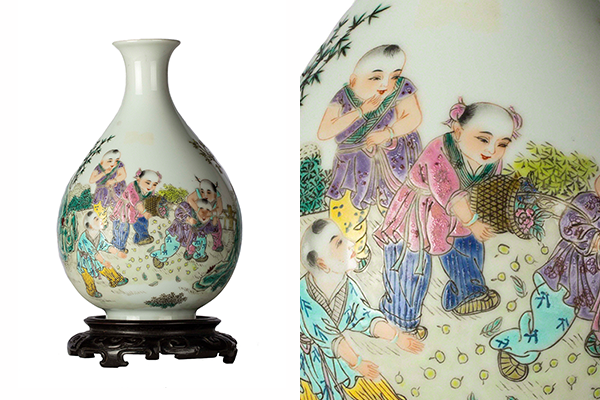 Famille Rose Porcelain Vase depicting peasant life in rural China
Famille Rose Porcelain Vase depicting peasant life in rural China
This is a famille rose porcelain which depicts young children playing. Famille rose porcelain refers to Chinese porcelain predominantly painted with pink colour enamel made from colloidal gold. It was first used during Kangxi’s reign [1661-1722] and during the early eighteen century was known as ‘fencai’ or ‘yangcai’ meaning foreign colour as it was first introduced from Europe in about 1685.
LEARN MORE ABOUT THIS VASE
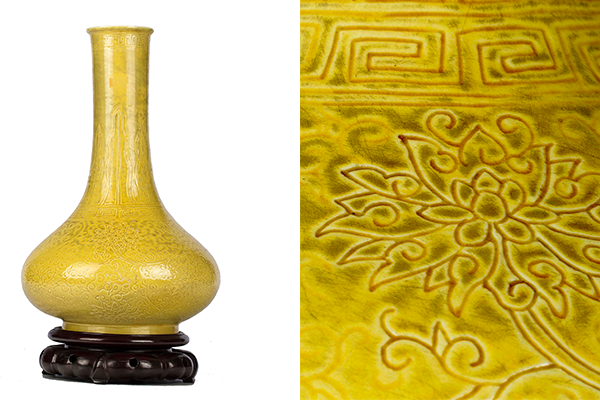 Imperial Yellow Porcelain Vase with intricate design
Imperial Yellow Porcelain Vase with intricate design
This piece is normally placed in the imperial temple. It is believed to be made during the Qing dynasty [1644-1911] for the Qianlong emperor [1735-1796].The two rings on the bottom indicates that it is indeed an imperial piece.
LEARN MORE ABOUT THIS VASE
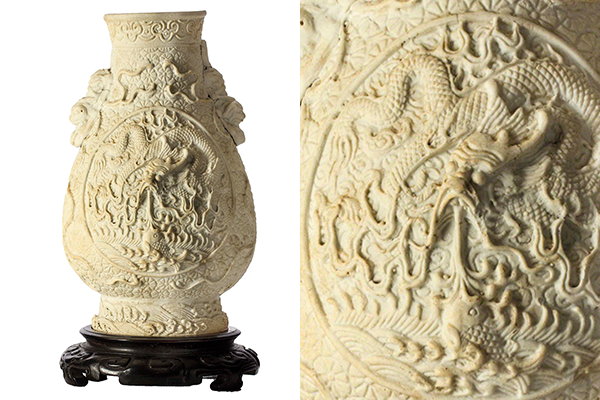 White Clay Vase with intricate carving of Dragon
White Clay Vase with intricate carving of Dragon
This piece is made from white clay and believed to be made during the late Qing period [1875-1916].In the late Shang dynasty, the emergence of white pottery with engravings marked a new achievement in Chinese pottery. Due to the hardness, lustration and fine craftsmanship, white pottery was used exclusively by the Chinese who owned slaves.
 Nine Peach Porcelain Vase
Nine Peach Porcelain Vase
Vases with nine peaches on it was very popular during the Qing [1644-1911] dynasty, especially while Guangxu was in power [1875-1908], and was used to celebrate the Empress Dowager’s birthday. Though it gained in popularity during the Guangxu period, it is said that the quality of vases decreased when compared to those during the Yonzheng [1722-1735] and and Qianlong reign [1735-1799].
LEARN MORE ABOUT THIS VASE
 Blue and White (Qinghua) Hexagonal Porcelain
Blue and White (Qinghua) Hexagonal Porcelain
This piece is a hexagon shaped vase with blue and white floral designs. The design is believed to be influenced by the Persians during the Tang dynasty [618-907].
LEARN MORE ABOUT THIS VASE
 Unique Green Porcelain Vase with Phoenix Handles
Unique Green Porcelain Vase with Phoenix Handles
This piece is made from a special glaze and has two phoenix handles. The phoenix is believed to embody the warmth of the sun and aids in producing male offspring.
LEARN MORE ABOUT THIS VASE

Imperial Double-handle Vase
Modelled after a similar vase crafted during the late Qing Dynasty, the cracked porcelain vase depicts a Phoenix and two Dragons playing with heavenly pearl. The Dragon is a mysterious mythical creature and a symbol of greatness that the Chinese take pride in since its creation. It is often depicted with the aura of strength and power. Chinese saw dragons with so much respect that each detail of the dragon was vital.
LEARN MORE ABOUT THIS VASE
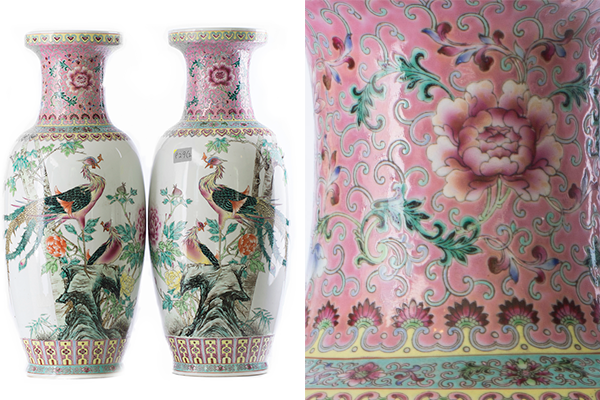
Two Wucai Porcelain Vases with Phoenixes Perched on Tree Peonies
This set of two porcelain vases depicts phoenixes perched on tree peonies (Chinese: 牡丹, pronounced ‘mu dan’) in bloom. These wucai (五彩, which gives a literal translation of ‘five colours’) porcelain vases features an exquisite design with a mixture of green and pink colour palettes, and is thus said to be of the famille verte and famille rose class of porcelain wares. The famille verte class of porcelain features designs with green and iron red enamel, and peaked in popularity in the period of Emperor Kangxi’s reign (1661-1720), while the famille rose class of porcelain was only introduced circa 1720 and primarily featured pink and purple colours.
LEARN MORE ABOUT THIS VASE
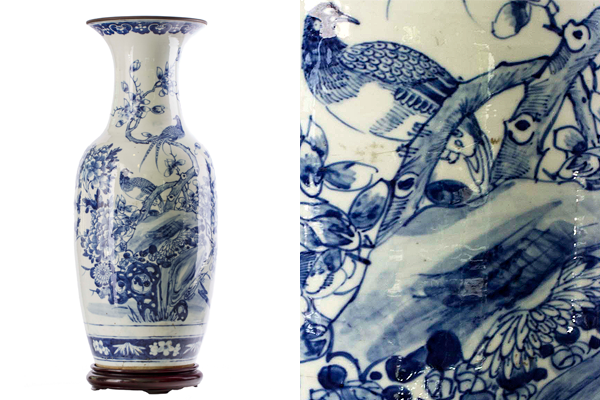
Blue and white porcelain vase with phoenixes and peonies
This set of two porcelain vases depicts phoenixes perched on tree peonies (Chinese: 牡丹, pronounced ‘mu dan’) in bloom. These wucai (五彩, which gives a literal translation of ‘five colours’) porcelain vases features an exquisite design with a mixture of green and pink colour palettes, and is thus said to be of the famille verte and famille rose class of porcelain wares. The famille verte class of porcelain features designs with green and iron red enamel, and peaked in popularity in the period of Emperor Kangxi’s reign (1661-1720), while the famille rose class of porcelain was only introduced circa 1720 and primarily featured pink and purple colors.
LEARN MORE ABOUT THIS VASE
RECENT COMMENTS